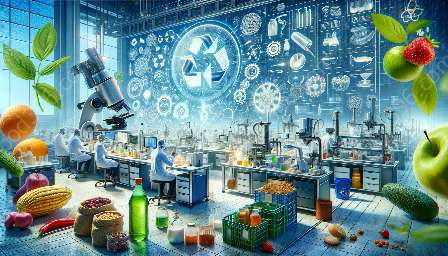Fermentation is a widely used process in the food industry, playing a crucial role in the production of various food products such as bread, cheese, yogurt, and beverages. This natural process, driven by microorganisms, not only alters the sensory properties of food but also contributes to the development of unique flavors, textures, and nutritional profiles.
Understanding the role of microorganisms in food fermentation is essential, as it intersects with the disciplines of food microbiology, food science, and technology. In this comprehensive guide, we will delve into the intricate world of microorganisms in food fermentation, exploring the scientific principles, technological applications, and diverse food products derived from this fascinating process.
The Science of Food Microbiology
Food microbiology is the study of microorganisms in food and their influence on the properties, safety, and quality of food products. Microorganisms are ubiquitous in nature and can be found virtually everywhere, including the environment, raw materials, and food processing facilities. In the context of food fermentation, certain types of microorganisms, such as bacteria, yeast, and molds, play a pivotal role in initiating and regulating the fermentation process.
Bacteria, the most diverse group of microorganisms, are often responsible for the fermentation of various foods. Lactic acid bacteria, such as Lactobacillus and Streptococcus, are commonly used in the fermentation of dairy products, vegetables, and sourdough bread. These bacteria produce lactic acid, which imparts the characteristic tangy flavor and acidity in fermented foods.
Yeast are single-celled fungi that are instrumental in the fermentation of alcoholic beverages, bread, and other fermented products. Species of Saccharomyces are particularly renowned for their role in converting sugars into alcohol and carbon dioxide during the fermentation process, leading to the production of beer, wine, and leavened bread.
Molds are filamentous fungi that contribute to the fermentation of certain cheese varieties and the production of enzymes for food processing. For example, the mold Penicillium roqueforti is crucial in the ripening of blue cheese, contributing to its characteristic blue veins and complex flavor profile.
Technological Applications in Food Science and Technology
Advancements in food science and technology have enabled the controlled and optimized utilization of microorganisms in food fermentation. From fermentation vessels and bioreactors to starter cultures and microbial enzymes, various technological tools are employed to harness the fermentative capabilities of microorganisms for food production.
Starter cultures are composed of specific strains of microorganisms that are carefully selected, cultured, and formulated to initiate and guide the fermentation process. These cultures can be used in the production of fermented dairy products, sausages, and pickles, ensuring consistency in the quality and safety of the final products.
Bioreactors are specialized vessels designed for the cultivation and maintenance of microorganisms under controlled conditions. In food fermentation, bioreactors facilitate the large-scale production of fermented products, allowing for precise regulation of temperature, pH, and oxygen levels to optimize microbial growth and metabolic activities.
Microbial enzymes, derived from microorganisms such as bacteria and fungi, play a crucial role in food processing and fermentation. These enzymes can break down complex substrates into simpler compounds, leading to desirable changes in the texture, flavor, and nutritional characteristics of food. For instance, the use of microbial rennet in cheese making results in the coagulation of milk proteins, essential for curd formation and subsequent cheese maturation.
Diverse Food Products Derived from Microbial Fermentation
The impact of microorganisms on food fermentation spans a multitude of culinary traditions and culinary delights, giving rise to a diverse array of fermented food products with distinctive sensory attributes and nutritional benefits.
Cheese is an iconic example of microbial fermentation, where the complex interplay of bacteria and molds transforms milk into a spectrum of cheese varieties, each with its unique flavor, texture, and aroma. From the creamy richness of Brie to the pungent tang of aged Cheddar, the diversity of cheese owes its roots to the microbial cultures involved in the fermentation process.
Yogurt, revered for its creamy texture and tangy taste, is the result of lactic acid fermentation by specific strains of lactic acid bacteria, predominantly Lactobacillus delbrueckii subsp. bulgaricus and Streptococcus thermophilus. This symbiotic relationship between the bacteria leads to the characteristic coagulation of milk proteins, yielding the smooth consistency and probiotic benefits of yogurt.
Kimchi, a traditional Korean fermented vegetable dish, undergoes lactic acid fermentation initiated by indigenous microflora and Lactobacillus strains. The resulting tangy, spicy, and pungent flavors of kimchi are attributed to the metabolic activities of these microorganisms, contributing to the preservation and enhancement of the sensory qualities of the fermented vegetables.
Sourdough Bread exemplifies the collaboration between yeast and lactic acid bacteria in the fermentation of dough, resulting in the production of carbon dioxide and organic acids. This symbiosis gives rise to the characteristic rise, texture, and complex flavors of sourdough bread, distinguishing it from conventionally leavened breads and highlighting the role of microorganisms in shaping the sensory attributes of baked goods.
Conclusion
Microorganisms play a pivotal role in food fermentation, shaping the sensory, nutritional, and safety aspects of a diverse range of fermented food products. The convergence of food microbiology, food science, and technology offers an in-depth understanding of the microbial dynamics involved in food fermentation, paving the way for innovations in food production and preservation.
From the scientific exploration of microbial metabolism to the technological advancements in fermentation processes, the influence of microorganisms on food fermentation extends far and wide, enriching our culinary experiences with a myriad of flavors, textures, and nutritional benefits.

